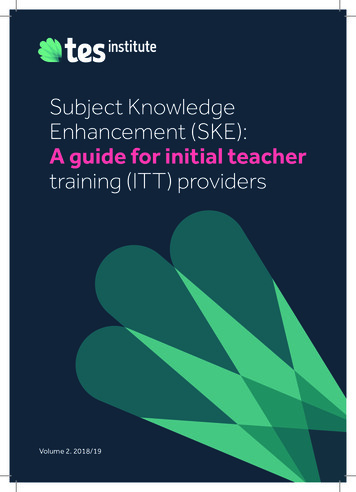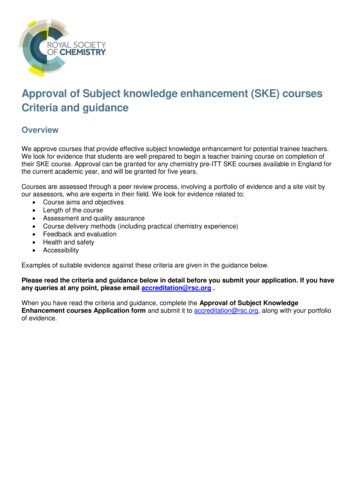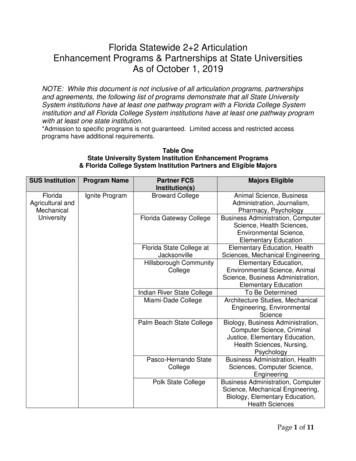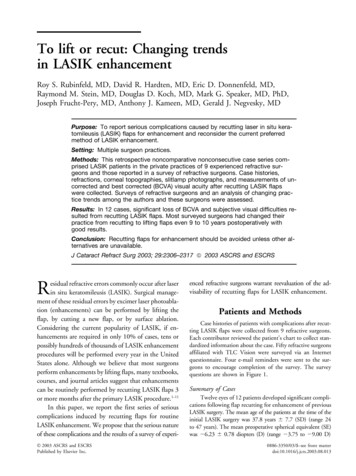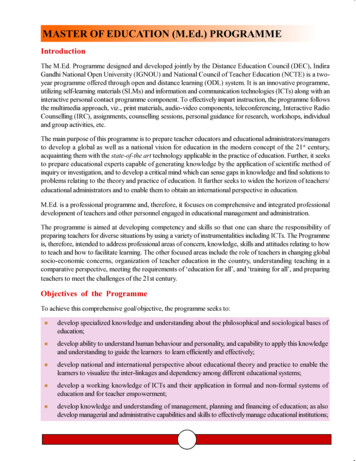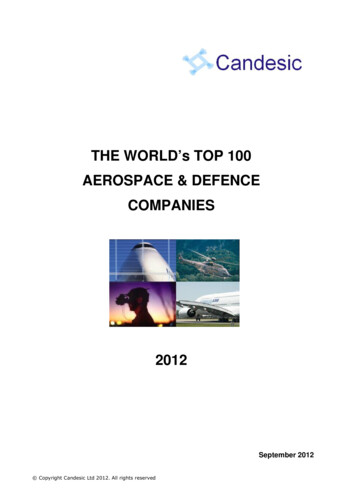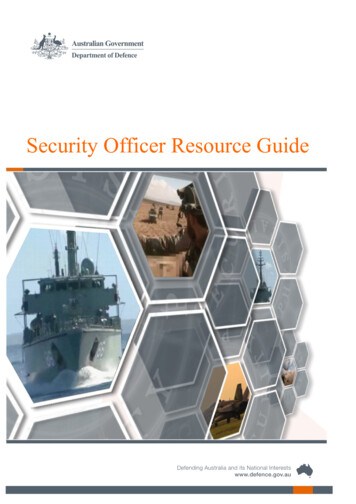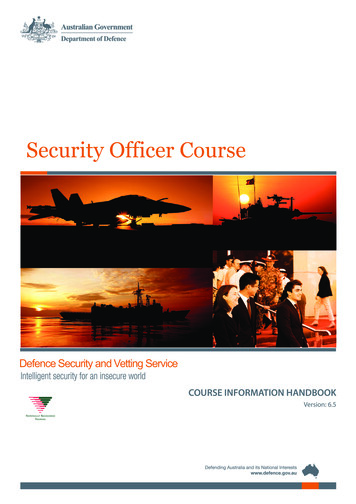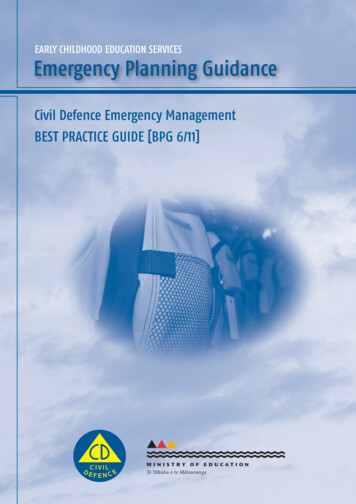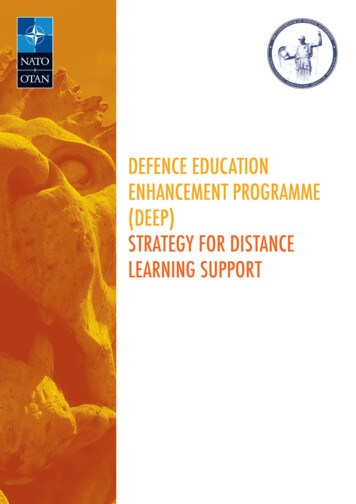
Transcription
DEFENCE EDUCATIONENHANCEMENT PROGRAMME(DEEP)STRATEGY FOR DISTANCELEARNING SUPPORT
1“ALL IS FLUX. NOTHING STAYS STILL.”HeraclitusThe digital transformation of defence education has only just begun. With the publicationof this strategy, we hope to make it easier for professional military education institutions toaccelerate the adoption of brand-new teaching methods and social learning environmentswhich leverage the tremendous potential of digital technologies. The role of technology inlearning environments is not to replace human interaction. Rather, its role should be toenhance the role of humans in the learning process, whether they be instructors or students.Technology is not the goal in itself. In fact, a digital transformation effort is likely to fail ifan organisation doesn’t integrate its operational and technology strategies from the start.This document is a response to that challenge, describing multiple options for modernizingdelivery of professional military education for which technology remains only a tool anddoes not become the master. Online learning, hybrid curricula, micro-learning, metaversebased social learning environments for geographically separated students these are just afew forms of distance learning support which could be harnessed to improve pedagogy andlearning outcomes.Reaching the full potential that digital technologies offer will take some time, but studentsshould expect cheaper, easier access to the highest-quality education and training, moreaccessibility for larger training audiences, information that is tailored to individual needs anddelivered anytime and anywhere, and programme delivery that is more resilient to disruption(whether pandemic, political, or security-related). This strategy will help you to guide yourown decisions as you design solutions that will work in your unique environment.I thank everyone who generously contributed their time and effort during drafting process.Marc Di PaoloDirector, Defence Institution and Capacity Building,NATO HQ
Published November 20212
1INTRODUCTIONThe Defence Education Enhancement Programme (DEEP) hosted a 16-18 November 2020 virtual workshop,followed by the co-hosting of a virtual conference with the War Studies University of Poland during 12-14 April2021 to identify best practices and lessons learned by Allied and Partner professional military education (PME)institutions in transforming education from residential to non-residential distance learning (DL) during the 20202021 COVID-19 evolution. There were approximately 200 participants representing 34 countries and a number ofmultinational institutions and schools. Utilizing the November 2020 workshop findings, the conference conductedpanels to review papers drafted in the period between the two events that elaborated on the findings developedby the first workshop. The April 2021 conference built on those papers to identify optimum approaches for theDEEP programme to inform a strategy for future advanced distributive learning (ADL) distance learning supportto Partner nations.It became very clear during the early period of the pandemic that our defence education institutions had to adaptand transform their resident education programmes into non-resident or hybrid approaches to learning. Even withthe many advances that the world’s medical community has made against COVID, we are still highly likely tocontinue to be impacted by the pandemic for the foreseeable future. That makes the really significant efforts putforth by the DEEP community in its support for defence education adaptation of distance and/or blended learningthat much more important as we consider the way ahead. Used correctly, this document has the ability to createand sustain the most effective, cost efficient, and versatile student-centred learning that our nations will require.3
2DEEP STRATEGY OBJECTIVEProvide DEEP programme guidance for Partner schools/countries that request support to develop, improve,modernize, and/or professionalize distance learning programmes. This will include the identification of potentialcourses of action that DEEP programme providers can employ to support Partner requests for support. Employedby DEEP providers to assist Partner schools and countries to attain their desired goals for distance learning capacityand execution, each course of action based on identified best practices/lessons learned will contain:A. End State: Objectives or desired outcomesB. Ways: Course of action approaches. Methods and processes executed to attain the ends. They answer thequestion: how are you going to get to the end state?C. Means: Resources required to execute the ways. It will also be important to ensure that any DEEP programmedistance learning support will be definitively assessed using the modern assessment, monitoring, and evaluationmethodologies associated with the SMART objective process (specific objective, measurable, achievable,relevant, time-related). Finally, DEEP programme support will require a sustainment component to allowfollow-on monitoring for success, failure, or modification.4
3BACKGROUNDA. Allied/Partner School DL Status and DEEP DL Support before COVID1) Before the pandemic, most PME institutions adhered to resident programmes that followed well-provenroutines in developing and implementing curricula. ADL, e-learning or distance/ online teaching existedto a greater or lesser degree but were often met with scepticism among PME faculty and the chain ofcommand.2) Most PME institutions focused on adapting the content and methodology necessary to keep their curriculaupdated and relevant. The general pattern of curriculum development, implementation, and review formeda consistent and permanent cycle. The learning environment remained essentially unchanged regarding itspredominantly residential character. This is a character manifested and understood by its physical naturesuch as classroom space, teaching materials, library access, information technology, and general learnersupport including but not limited to social, morale, and welfare considerations; see Annex I.3) The emphasis on the use of e-learning was employed for asynchronous education before the COVID-19period, as demonstrated by the COVID-19 Online Learning Survey in Annex I.4) Most virtual teaching platforms employed were asynchronous: Learning Management Systems – ILIASand Moodle (both open-source).5) DEEP DL support capacity before COVID – by individual area of support:a) Institutional Support On-demand country-specific workshops on potential adaptation of a distance learning system –sharing the best practices based on the Ukraine PME ADL system solutions (Annex J, Annex K).b) Curriculum Development On-demand country specific workshops on development for specific distance learning curricula.c) Faculty Development On-demand country-specific workshops on the use of distance learning ADL tools by facultymembers.d) ADL Technology Support NATO DEEP ADL Portal based on ILIAS, as a system solution for all partner countries. On-demand workshops to address the employment of distance learning ADL technology – inaccordance with Partner institution demands.e) English Language Training (ELT) NATO DEEP ADL Portal based ELT courses (ELTEC) available for registered users5
B. Allied and Partner School DL Status, and DEEP DL Support During COVID1) The changes brought about by Covid-19 unleashed new dynamics among PME faculties. Curriculumdevelopers and classroom instructors had to determine what and how to teach in a distance learningenvironment. This included identification of needed ADL technology to support the new effort. Teacherswith more experience helped those who lacked necessary IT skills; in many schools, motivation andgoodwill spilled over from the change agents to the sceptics.2) Some schools established new internal bodies – steering committees and working groups – to overseethe curriculum transformation from resident to virtual/hybrid modalities. Other schools relied on smallteams of empowered experts who oversaw curriculum development in a comprehensive manner. Theseexperts were the primary points of contact for faculty that, overall, carried an increasing responsibility fortransitioning their teaching to the virtual realm.3) For academic faculty with a high degree of freedom of research and teaching or experience in developingtheir classes and lessons, the changes were made more easily. Instructors in more regulated or trainingoriented programmes faced additional challenges regarding individual curricula or individual schooleducation decision-making - as they may have lacked the agency or knowledge, or freedom to adapt on thefly.4) The most common problems PME institutions faced during the transformation from residential to nonresidential distance learning were:a) Legal aspects of a distance learning ADL system.b) Limited faculty experience in extensive utilization of distance learning.c) Lack of a dedicated distance learning ADL administrative staff.d) Absence of ADL platform/software system solutions.e) Need for appropriate distance learning ADL system hardware.5) Prior to the pandemic, in some cases, distance learning was primarily seen only as a hypothetical possibility.Important technological and organizational issues were frequently not addressed for distance learning. Toresolve this issue, it has been necessary to address:a) Means (Resources): To ensure the remote learning can take place, the instructor must use differenttypes of equipment and software. This could include equipment for a remote workplace at home(Telework).b) Skills: To work successfully in a distance learning format, the instructor must have additional skillsand knowledge. In the end, the instructor’s professional profile can be divided into between distancelearning and resident learning.c) Formatting Materials: Training materials prepared for in-person teaching could require significantredesign for use in a distance learning environment.d) Communication: A lot of time is spent on unscheduled communication which also needs to beformalized and limited. Along with the enthusiasm for mastering several professional competencies inthe context of “quarantine training,” instructors quickly tired of constant communication online anda significant number of tasks that they received for evaluation.e) Technology Tools: Schools/Instructors were free to select the distance learning technology tools.This also required the student to master a new “set of distance learning tools and technologies.” It islogical to have a basic (mandatory) standardised learning environment like LMS for all courses and arecommended list of additional tools.f ) Distance Learning Policies: School distance learning polices will have to be developed at both thenational and individual school levels.6) As per the Annex I survey, a little more than 50% of survey responders indicated multiple problems withdistance learning-associated technology. In addition, about 2/3 of the Annex I survey respondents statedthat there was little to no training or support for faculty to begin teaching in a distance learning mode.6
7) Nevertheless, according to the NATO COVID-19 Online Learning Survey (Annex I), synchronousdistance learning increased 202% and asynchronous learning expanded 59% during the COVID period.8) Multiple platform portals have been employed for synchronous instruction: MS Teams, Google Meets,Google Hangouts, Zoom, Webex, Gotowebinar, GotoConference, GoToMeeting, ClickMeeting, Jitsi,Adobe Connect, BigBlueButton. For asynchronous instruction, the Learning Management System (LMS)ILIAS and Moodle continued as the platform portals of choice.9) DEEP DL Support During COVID by Individual Area of Support:a) Institutional Support (see Annex L for a generic model that could be utilized by school for transformationfrom resident to non-resident learning) On-demand country-specific workshops on potential adaptation of a distance learning system.b) Curriculum Development On-demand country-specific workshops on development for specific distance learning curricula.c) Faculty Development Postgraduate studies – E-teacher and e-instructor within the new COVID-19 learningenvironment.1 Beginning with academic year 2021/2022 - e-Instructor Certification Programme (five monthsin length, two classes have graduated).2 Running Effective Virtual Meetings – over a year of continuous BigBlueButton training supportwithin the NATO DEEP community.3 Micro-Learning Design with H5P – e-course focused on an open-source authoring tool – H5P(more at: https://www.youtube.com/watch?v 5VnGOkWIDfM&t 1s).4 Multimedia Tools for e-Teacher and e-Instructor – developing engaging podcasts and videocasts(more at: https://www.youtube.com/watch?v w4TuUo 9Qpc).5 Translation of the “Modernizing Learning” book into Ukrainian and other e-learning productsby the NATO DEEP eAcademy. Conversion from ILIAS SCORM Editor to Articulate Rise: 10 Principles of Cybersecurity(currently available in English and Ukrainian) Conversion from ILIAS SCORM Editor to Articulate Rise: Introduction to Cultural Awareness The initial process has begun to transform the Counterterrorism Reference Curriculum intoa reference curriculum for a distance learning course. That will likely be followed by a similartransformation for the Cyber Security Reference Curriculum. Both reference curricula to beavailable in multiple languages. Many country-specific workshops.1 The studies were conducted within the framework of the cooperation between NATO’s Defence Education Enhancement Programme and the EuropeanSecurity and Defence College of the European Union. Ten subjects were conducted by lecturers from the NATO Defence College in Rome (Italy), NATOSchool Oberammergau (Germany), UWM Olsztyn, European Security and Defence College of the European Union, and the eAcademy of NATO’sDefence Education Enhancement Programme. Three participants received a special "Jean d’Andurain Prize" - for the best student to commemorate thefounder of NATO’s Defence Education Enhancement Programme (https://www.nato.int/cps/en/natohq/news 185832.htm?selectedLocale en, accessed2021-07-28).2 NATO DEEP eAcademy will continue to support instructors with a new “e-Instructor Certification Programme” that will prepare civil and military facultyin professional military education institutions to become fully operational in e-learning environments and will provide knowledge on how to design, planand implement remote classes and courses. (https://www.nato.int/cps/en/natohq/news 185832.htm?selectedLocale en, accessed 2021-07-28).3 From May 2020 to June 2021 - 80 sessions were conducted by two NATO DEEP eAcademy teams, 240 participants.4 From February 2021 to July 2021 - 12 sessions were conducted by NATO DEEP eAcademy team, 80 participants.5 From April 2021 to July 2021 – 8 sessions were conducted by the NATO DEEP eAcademy team for 64 participants (see: 1. Gawliczek P., Guzewicz W.,Iskandarov Kh., Defence Education Enhancement Programme as a Vehicle to Strengthen and Stimulate Cooperation Between NATO and Partners: CaseStudies - South Caucasus and Ukraine ADL Perspectives, Publishing House UWM, Olsztyn, 2020; and 2. Gawliczek P., Innovative ICT Solutions and/within/for Changing Security Environments: Case Study - NATO DEEP ADL Portal and Social Media, Social Developments, and Security, 2019, 9 (4)p.111-119).7
d) ADL Technology Support NATO DEEP ADL Portal – based on ILIAS (5.4.12. version to be updated to 7.2 version), NATO DEEP Video Conferencing Portal – BigBlueButton (2.2 version to be updated to 2.3version) NATO DEEP eAcademy Moodle – a platform established for training purposes, with H5Pdevelopment capabilities. Hosting the Iraqi E-learning Platform (IeLP) – from July 2021 (moved from ACT server)e) English Language Training (ELT) 8CALT – Computer Adaptive Language Testing installation will be available to any interestedPartner instructor
4ASSUMPTIONSA. Partner Desires Support: The DEEP Programme Could Support Partner Schools in the Following Ways:1) Training Aspects: Provide training on: Ways of Developing an ADL System: Utilizing the experience of countries that have already developedtheir own distance learning systems, focus on all the important steps that need to be taken to build thesystem. Demonstrate the practical results of the implementation of these steps. Approaches to Shift from Traditional to Distance Learning: Extensive experience was gained during thepandemic on the transition from traditional to distance learning in various combinations. Accumulatingthis practical experience and conducting associated training will help education institutions, that areon the initial path, as well as those which are already actively using distance learning technologies. Use of Learning Management Systems (LMS) to Support Educational Processes in PME Institutions:There are many options for organizing the educational process using LMS, from the placement of ADLCourses on it to comprehensive support of the educational process where ADL Courses are only thepart of the complex system. It is important to know the possible options for using the LMSs, the prosand cons of each option or their combinations, and the sequence of actions to implement a certainoption. In addition, it is very important to understand how to use the LMSs from the perspective ofthe instructor, student, and administrator. Assistance in organizing such training is necessary, as well asassistance in developing training programmes for further implementation. Use of Different Authoring Tools to Create Distance Learning Materials: The large number of tools fordeveloping ADL content for use in the ADL system can create difficulties for instructors. It is useful toprepare instructors to use the tools they need to master their specific tasks. edagogical Approaches in Distance Learning: Many pedagogical approaches exist in the ADL system,so mastering them is very important for a modern instructor. Training on a variety of approachesimplemented during the pandemic period, both positive and negative aspects, should be required. Administrative Aspects: Conduct consultations with DEEP Country security sector leadership onthe ways to build a distance learning system based on the successful experience of Partner countriesand support their implementation. Provide assistance in the development of legislative documents forPartner ADL systems by disseminating and translating existing documents used by the countries thathave already implemented ADL systems.B. Support Funding Availability: DEEP will continue to provide financial support to those Partners willing todevelop an DL capacity.C. SME Availability: DEEP should be able to meet the demands related to the “e-Instructor CertificationProgramme” and other specific related demands provided by Partner education institutions. Within theNATO DEEP eAcademy there are instructional designers, multimedia designers, programmers, LMS ILIASadministrators, LMS Moodle administrators, UI and UX designers. Considering the trends, the team will alsobe able to support the VR/AR/MR and AI fields.9
D. Technology Capacity to Support: Types of platforms, etc. available in 2021; include cost estimates by platform1) NATO DEEP ADL Portal – cost: 15k EUR/ year (cloud hosting, maintenance, helpdesk, and upgrading)2) NATO DEEP VC Portal – cost: 10k EUR / year (cloud hosting, maintenance, helpdesk, and upgrading)3) NATO DEEP eAcademy Moodle – cost: 5k EUR/ year (cloud hosting, maintenance, helpdesk, andupgrading)10
5IDENTIFICATION OF POTENTIAL COURSES OF ACTION FOR FUTURE DEEP SUPPORTTo ensure maximum options and flexibility for both the Partner country and DEEP providers, multiple distancelearning areas have been identified that can be supported. Potential courses of action (combined with best practices/lessons learned) for each of the five identified distance learning fields follow:A. Institutional Support:1) End State: Professional administration and management organization, and system in place to support amodern distance learning programme.2) Challenges: Faced by PME institutions during the transformation process from residential to nonresidential distance learning were:a) Legal requirements for the distance learning systemb) Limited faculty experience in distance learning education and trainingc) Lack of a dedicated distance learning support staffd) Absence of technology: workable ADL platform and other needed ADL softwaree) Needed ADL system hardware (e.g., computers)3) Potential Course of Action Options (combined with best practices/lessons learned): To supportinstitutional transformation towards distance learning, the following approaches should be considered:a) Conduct an institutional evaluation to identify the strengths and weaknesses of the educationinstitution’s internal quality assurance and quality development procedures needed to optimize distancelearning organizational structures. The institutional evaluation needs to identify what the PMEinstitutions should do to shift from residential to non-residential learning. Key will be identificationof the necessary changes in hardware, software selection, resource needs (e.g., money, time, staff etc.),and an overall organizational approach.b) Determine why the changes are needed to allow distance learning to be delivered at the institution.Both challenges and opportunities must be evaluated. The identified changes should be determinedin terms of products, technology, structure, and culture. The Partner institution should identify anindividual that takes leadership responsibility to implement any planned changes. That person mustbe alert to things that need revamping, open to good ideas, and supportive of the implementation ofthose ideas into actual practice.c) Distance education institutions have access to a local area network (LAN). The LAN must providemaximum access to the internet and all required network capacity. The school may be required to makea policy decision to extend the LAN into school dormitory areas or be updated.d) Must decide on the best learning management system (LMS) and videoconferences servers or look fora cloud solution for the Partner school; all with the needed certification.e) Ensure an appropriate level of cybersecurity for all distance learning services.11
f ) There is a need to determine needed services and software.g) Dedicated school administrative entities (e.g., branches, centres, departments) should be created tosupport faculty/student ADL utilization at the highest level, which may require MoD/General Staffadministrative approval. The teaching staffs will require support from the highest levels.h) A NATO based Cloud service could help some Partners in case of experience deficiency and/or resourceshortages.i)During the transformation process from resident to non-resident learning, the conduct of a weeklyreview by Partner schools could facilitate the monitoring and fast adaptation in variable conditions.j)School schedules may have to be adjusted for the planned start and graduation of cadets several yearsinto the future to ensure that quality of education and training can be maintained.k) For overall faculty development, provide training for faculty on technical and pedagogical aspects ofusing ADL in the educational process. Create two courses for the faculty: basic and advanced courses.For the basic course – focus on essential functionality to conduct classes online. For the advanced course– focus on more advanced pedagogical aspects.l)Ensure availability of training videos or text materials that describe the basics of developing distancelearning courses, and the peculiarities of organizing and conducting classes in distance mode will beimportant.m) Provide funding and central support to the teaching staff that are re-engineering their course designsto best use technology-enhanced approaches.n) The ability to conduct group and collective projects in a distance learning mode will be important. Thisrelates to the collection, processing, and analysis of information for research topics. This will requireconstant contact between the instructor and the individual student work groups.o) Collaboration among schools in the same Partner country is important for the adaptation of otherdistance learning best practices/lessons learned. A joint distance learning platform can be used byseveral PME institutions to facilitate the process of implementing distance learning technologies intothe educational process. It also allows economic efficiency and facilitates the solution of administrativeand personnel issues related to the management of the platform.p) Given the conditions of the individual Partner school, a hybrid approach for both resident and nonresident learning could be a preferred solution.q) As available, employ the experience of other countries in the development of their own distancelearning systems. Demonstrate the practical results of their implementation.r) If possible, DEEP portals should be provided for Partner PME institutions to support their educationalprocesses. This will minimize Partner financial and time costs, to include the purchase of expensivehardware and software and the need for technical specialists to install and maintain them. One examplecould be a multi-tenant LMS for PME institutions where multiple independent organs operate in ashared environment (e. g., MOODLE example)s) Assist partner countries with the development of legal documents that a country may need for theestablishment of a distance learning system.12
B. Curriculum Development1) End State: Modern curriculum/curricula in place written specifically for an on-line learning classroom.This would include exercises, research projects, and student measurement (e.g., written and oral tests,student in-class presentations, etc.).2) Challenges: Faced by PME institutions during the transformation process from residential to nonresidential distance learning were:a) Many PME institutions lack both essential tools (computers, cameras, electronic dashboards etc.) andtechnical prerequisites (high-speed internet, bandwidth, access to online libraries and databases etc.).b) Technical and practical subjects are more challenging to transform into online lessons or exercises thantheoretical subjects. Virtual or Augmented Reality (VR/AR) may offer viable solutions but requiresadditional equipment, training, expertise, and time to develop.c) Online devices are often subject to security restrictions – and face the general suspicion of distractingstudents from their genuine work.d) Testing procedures and practical application of newly acquired knowledge also need to be adapted tovirtual modalities.e) Overall, distance learning curriculum development requires more time and resources, and moreassistance to both faculty and students than the preparation of traditional face-to-face programmes.Online teaching cannot replace the social interaction between all actors involved in teaching andlearning processes. Especially in military education, establishing trustful relationships between leaders,subordinates, and peers is essential for the successful execution of tasks and missions – and it can onlygrow through permanent personal contact. Therefore, blended or hybrid curricula should create asmuch space as possible for real-time and near real-time interaction.3) Potential Course of Action Options (combined with best practices/lessons learned):a) Development of online/hybrid curricula requires thorough preparation and planning that integratescurriculum designers, instructors, and technical staff/trainers to determine what shall be learned andhow.b) Online sessions need to be modelled for online execution.c) The preparation/presentation of modules or lessons could be done by two peer instructors who providecomplementary views and expertise and can back up each other.d) Curriculum planners/course directors need to set clear timelines to deliver readings, teaching materials,and lesson concepts. If possible, there should be dry runs or rehearsals to evaluate and tweak themodule/lesson.e) Students need precise information on the courses/modules/lesson and access to readings/materialin time to absorb the material prior to classroom delivery. Instructors should provide easy-to-followmaterial and avoid “cognitive overkill” where possible.f ) To maintain student motivation and attention span, instructors should apply various active learningmethods and approaches to activate and involve their classes. This includes giving exercises orpresentation requirements to students to work on during asynchronous periods and then present theresults during the plenary sessions.g) Online/hybrid curricula need as many live synchronous sessions as possible to maintain a socialconnection between instructors and students.h) Immediate student feedback is essential for the development/consolidation of online/hybrid curricula,especially during the initial phases.i)Pilot courses/lessons offer the opportunity to test a new module/lesson throughout the cycle ofdevelopment, implementation, and evaluation of a curriculum.j)To reduce confusion and training hours, a PME institution should use one common standard platformand learning management system (e.g., Moodle, ZOOM, BBB, etc.) to execute its online/hybridcurricula.13
C. Faculty Development1) End State: Partner school instructors can design and deliver lessons using active learning methods in adistance learning classroom (both synchronous and asynchronous).2) Challenges: Faced by PME institutions during the transformation process from residential to nonresidential distance learning were:a) Partner schools may have a limited or unreliable ADL (Virtual Conferencing System and LMS access).b) Partner schools may have limited or non-existent teaching and faculty development resources.c) Partner schools/countries may not have the fiscal resourc
f) Distance Learning Policies: School distance learning polices will have to be developed at both the national and individual school levels. 6) As per the Annex I survey, a little more than 50% of survey responders indicated multiple problems with distance learning-associated technology. In addition, about 2

